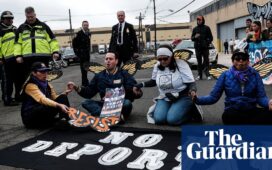Since the beginning of 2019, Donald Trump’s presidential campaign launched more than 2,000 ads on social media that warn people of the supposed threat of Latinx people. The aim of the ads was to mobilize support for a border wall and for border security by heightening fears of a migrant “invasion”. As a scholar who is working on a book about the history of border enforcement technologies such as drones, I know this is not the first time that Latinx people have been targeted by racist and xenophobic discourse that treats them as an invading force. Calls for border security today cannot be disentangled from the longer history of racist, white anxiety about black and brown bodies.
The notion that Latinx people constitute a “threat”, and more specifically an “invasion”, has not been a fringe view for decades. Instead, it has been an integral part of the border security framework throughout the second half of the 20th century. The former Immigration and Naturalization Service (INS) commissioner Leonard F Chapman told the Congress in 1975 that the service was overwhelmed with a “deluge of illegal aliens, particularly on the United States/Mexico border, [that] must be checked”.
Faced with an economic recession in the early 1970s, Chapman sought to construct a sense of emergency that would force the hand of lawmakers to assign more funds and resources to INS. He was savvy in his use of the public sphere to pressure the Congress. In an October 1976 article for Reader’s Digest, he decried how “illegal aliens”, at the time predominantly imagined as Mexicans or broadly Latin American, constituted a “vast and silent invasion”. A former marines general, Chapman’s effort succeeded in increasing collaborations between the Department of Defense and INS.
Newspapers also helped promulgate racist tropes when talking about Latinx migrants. In this period, it was not rare to read the racist epithet “wetback” in big headlines about border enforcement, unauthorized migration and anxieties around the labor market. The New York Times and the Los Angeles Times even echoed the language of war used by Chapman – of a “silent invasion” (1977) and of “illegal aliens win[ning] a beachhead” (1978), respectively – to describe immigration and the border. Talk of illegal alien invasions and of migrant intruders in the 1970s helped justify the increasing use of war technologies on the southern border which, as my research shows, included the testing of an “electronic fence”.
These technologies, among other things, gave rise to the strategy of “prevention through deterrence” in the 1990s. This strategy had a direct effect on the rise of migrant deaths in the Sonoran desert of Arizona, what Jason De León calls the “land of open graves”. “Prevention through deterrence” sought to make unauthorized border crossing so arduous and dangerous that it would dissuade migrants. To do so, the policy required the combination of fences, high-intensity lighting, large numbers of border patrol agents near the US-Mexico boundary and technologies like the “electronic fence” of the 1970s. This way of approaching the border disregarded the lives of migrants by pushing them into more vulnerable, life-threatening terrain. The American Civil Liberties Union estimated that the resulting death toll of these approaches ranged from 3,861 to 5,607 from 1994 to 2009.
Latinx lives continue to be in danger. More than 900 children have been separated from families since US court ordered a stop to the practice. With migrants and even some US citizens being “submitted to cruel and inhumane treatment prohibited by international law”, the number of in-custody deaths continue to rise. At the same time, scholars have shown that Immigration and Customs Enforcement (Ice) operations have deleterious impacts on the health of migrants and their communities. More recently, the white nationalist rhetoric found in the manifesto published prior to the attack in El Paso echoed Trump’s racist tropes by singling out a “Hispanic invasion”.
The manifesto and terrorist attack were inspired by the vision of a white ethnostate, a national state designed to save white America by dividing the country into racial regions. Border security and white supremacist terror work together in producing such a state as they target Latinx communities and push them into a bare life. The connections between border security and white supremacy intensify the vulnerability of black and brown bodies in the racist delusion of protecting white frailty. We cannot disentangle border security infrastructures (ie border wall, prisons, deportation raids) propped up to manage Latinx people from the violent racism and xenophobia that justified and continue to justify them.
Calls to approach immigration and the border through the framework of security perpetuate this vulnerability. If we are to begin dismantling white supremacy, we must undo the border security paradigm and the ways it profits from creating Latinx vulnerabilities. We need an approach to immigration and to the lives of Latinx people that centers their human rights and their dignity.








